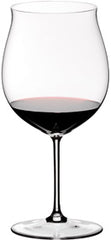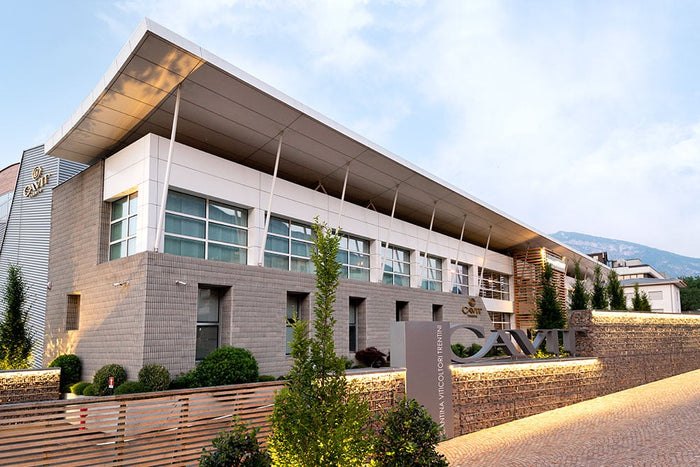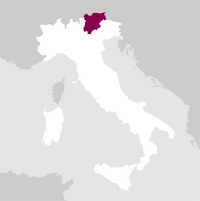Description
Cépage originaire du sud-ouest de la France, notamment de la région de Bordeaux, où il constitue, avec le cabernet, l'assemblage de base de certains des vins les plus prestigieux de la Gironde. Les premières mentions du merlot remontent à la fin du XVIIIe siècle et la première description de Rendre date de 1854. De la France, il s'est répandu dans le Trentin à la fin du XIXe siècle, où il a trouvé dans certaines zones les conditions environnementales les plus propices à sa culture. Ce cépage préfère les zones de basse colline bien ventilées, avec des sols argilo-calcaires et un système de formation en cordon ou en Guyot. Le Merlot fait désormais partie des vins typiques du Trentin et a conquis de nouveaux admirateurs pour ses caractéristiques de structure, de personnalité et d'évolution élégante.
Détails

Parfum

Couleur

Goût
Servir à :
16 - 18 °C.
Longévité :
03 - 05 ans
Temps de décantation :
1 heure

Accords
- Année de création: 1950
- Oenologue: Paolo Turra, Guido Mattiello, Fabrizio Marinconz, Andrea Faustini
- Hectares: 6.350
Fondée en 1950 pour répondre au besoin des viticulteurs de la région d'offrir la meilleure qualité et de proposer leurs vins de manière moderne, elle représente aujourd'hui plus de 4 500 viticulteurs associés à 11 caves et 65 % de la production viticole du Trentin (environ 5 700 ha). Cavit collecte, examine et sélectionne les matières premières provenant des meilleures productions des caves associées, en les soumettant à des contrôles stricts à chaque étape : de l'affinage à la mise en bouteille. L'un des engagements de Cavit est également celui de la formation et de la diffusion des connaissances œnologiques, c'est pourquoi l'entreprise collabore avec l'une des plus importantes écoles œnologiques nationales : l'Istituto Agrario di San Michele all'Adige (Fondation Edmun Mach), un centre renommé pour l'expérimentation avancée du vin et un point d'observation du monde de l'œnologie qui forme les techniciens les plus qualifiés.
En particulier, Cavit collabore avec l'Istituto Agrario di San Michele all'Adige dans le cadre du projet "Il Maso", qui consiste à identifier des écosystèmes particulièrement favorables et, grâce à des techniques de vinification très soignées et à l'utilisation de cépages particulièrement prisés, à produire des vins de la plus haute qualité, élaborés uniquement dans les meilleurs millésimes.
Les vins suivants ont été primés au Concours national des vins Rosé Rosé 2022 : - TRENTODOC ALTEMASI ROSE' - ROSA D'ORO : note 94/100 - TRENTINO DOC SCHIAVA GENTILE BOTTEGA VINAI 2021 - ROSA D'ORO : note 92/100 Les vins primés seront inclus dans le Guide du Rosé Rosé - Guide to Drinking Rose 2022. Lire la suite


| Nom | Bottega Vinai Merlot Trentino 2021 |
|---|---|
| Type | Rouge tranquille |
| Dénomination | Trentino DOC |
| Millésime | 2021 |
| Format | 0,75 l |
| Teneur en alcool | 13.5% par volume |
| Cépages | 100% Merlot |
| Pays | Italie |
| Région | Trentin-Haut-Adige |
| Fournisseur | Cavit |
| Origine | Les collines les mieux exposées de Vallagarina et de la région de Trente |
| Climat | Les climats de ces régions sont subcontinentaux, avec des hivers froids, souvent enneigés, et des étés chauds, mais avec une bonne amplitude thermique entre le jour et la nuit. Dans la Vallagarina, on trouve également l'influence bénéfique de l'Ora del Garda, une brise agréable qui se lève dans l'après-midi depuis le lac de Garde. |
| Composition du sol | À Vallagarina, les vignobles sont situés sur les conoïdes formés par les dépôts d'anciens cours d'eau, où l'on trouve des sols calcaires bien structurés et bien drainés, avec une bonne teneur en argile. Sur les collines entourant Trente, les vignobles se trouvent sur des terrasses glaciaires ou morainiques, avec des sols profonds, bien drainés et bien argileux. |
| Rendement par hectare | 55 hl/ha |
| Récolte | Les raisins sont récoltés à pleine maturité à la fin du mois de septembre, seulement lorsqu'ils ont atteint une maturité phénolique optimale. |
| Température de fermentation | 28 °C (maximum) |
| Vinification | Après l'égrappage, le moût est fermenté en contact avec les peaux pendant environ 12 4 jours à une température ne dépassant pas 28 °C dans des récipients en acier inoxydable. |
| Vieillissement | Après la fermentation, le vin est élevé en barriques de chêne français. Il est ensuite élevé pendant une courte période dans des fûts de chêne de Slavonie avant d'être mis en bouteille. |
| Acidité totale | 4.6 gr/L |
| Extrait sec | 29.0 gr/L |
| Allergènes | Contient des sulfites |




